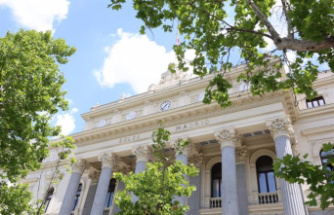Surrounded by a plaza that rises menacingly above the sidewalk, its black and bronze-colored walls slamming straight to the ground from above, Willis Tower has always seemed like it was designed to repel people. And perhaps it was, in light of the riots that devastated Chicago's West Side six years before the skyscraper's 1974 opening as Sears Tower.
Forty-three years later, with tech firms, restaurants and residential towers having long ago turned sections of the West Loop from urban battleground to urban playground, Willis no longer occupies downtown's wild west border. That helps explain why the tower's owners will announce a $500 million upgrade Wednesday, including a complete revamp of the building at street level.
The forbidding plaza will disappear, replaced by a three-story retail structure that wraps around the 110-story tower's base and has rooftop green space. "It's an incredible vote of confidence to spend a half a billion dollars in the city," Mayor Rahm Emanuel said in an interview Tuesday, adding that he likes the design's update of a modernist icon.
My take is more mixed. While the re-design should make Willis more welcoming to passers-by and could enliven the now-dull South Wacker Drive office canyon, the change will come at a cost: A subordination of the skyscraper's base into the new retail structure weakens the building's defining muscularity. In renderings, the revamped tower looks like a big guy cut off at the ankles.
Designed by Chicago architects Skidmore, Owings & Merrill, Willis's design was based on a structural innovation called the "bundled tube" that worked like this: Nine 75-by-75 foot tubes of steel were bundled together like sticks, with some of the tubes dropping off as the tower rose. The arrangement of rigid, interlocked tubes created an immensely strong, relatively lightweight and exceptionally economical framing system that did not place a financial premium on height.
Willis Tower Gensler / BlackstoneRendering of the northwest corner of Willis Tower.
Rendering of the northwest corner of Willis Tower.
(Gensler / Blackstone)This powerhouse expression of Chicago's industrial-era might was meant to be "of the people," but it was hardly welcoming to real people at street level. Portions of the plaza's red granite surface are actually slanted, making it difficult to set down a chair.
"We see the building as a bit of a fortress," said Jon Gray, global head of real estate for New York-based Blackstone, which bought Willis for $1.3 billion in 2015. "We want to create a place that is a true destination."
While it is typical for developers to talk big about creating "destinations," the scope of the project suggests it could make a significant impact. Here are the rough outlines, as provided in interviews with Gray and representatives of Equity Office, a Blackstone affiliate:
•The revamp will add 150,000 square feet of amenities for the building's office tenants, including a lounge, cafe and fitness center. The office portion of the tower is 85 percent leased. But Willis is being pressed by new, well-appointed towers like the curvy River Point at 444 W. Lake St.
Willis Tower Gensler/BlackstoneRendering of proposed retail facility at base of Willis Tower.
Rendering of proposed retail facility at base of Willis Tower.
(Gensler/Blackstone)•Willis' 103rd-floor skydeck could be expanded to the 102nd Gobahis floor and could include a new attraction that offers "a brand new perspective on what it's like at 1,353 feet and looking down," said Paul Kurzawa, Equity Office's managing director of development. The skydeck, which draws about 1.7 million annual visitors, already features the Ledge, a glass balcony that extends outside the tower's exterior.
•The new retail structure will encompass 300,000 square feet including a winter garden off Jackson Boulevard ringed by shops and restaurants; a revamped belowground entrance to the Skydeck; and the retention of Willis' on-site post office. (The tower is so large that it has its own ZIP Code — 60606.) The rooftop garden, nearly three-quarters of an acre in size, will be open to the public.
Construction is expected to begin in the first quarter of this year, Gray said, with completion due in 2019. Because no zoning change was needed, public hearings were not required.
Blackstone did not announce any tenants, but Gray said the firm is negotiating letters of intent for more than half the space in the new retail structure. The new retail structure was designed by the Chicago office of Gensler, which has distinguished itself in such projects as the modernist addition to Fourth Presbyterian Church and disappointed with Block 37's banal retail mall.
To Gensler's credit, the planned retail structure is respectful of Willis' powerful architecture but not reverential. Its trellis-like framework honors the building's metal-and-glass palette and right-angled geometry. Yet there are subtle differences, evident in the profusion of transparent storefronts along the street and the wave-shaped ceiling that will top the winter garden.
Wisely, the re-design gets rid of the lunchbox-shaped, SOM-designed entrance pavilion along Wacker, which was added in 1985 and is essentially a small object tacked onto the bigger object of the tower. Entrance canopies along Jackson and Franklin Street will also be replaced with new ones.
The architects also are addressing security issues, which have loomed in the background for the iconic tower since the Sept. 11, 2001, attacks brought down New York's World Trade Center. On the outside walls of the retail structure, Gensler plans to use double-laminated glass, which is less prone than normal glass to break into dangerous flying shards.
When it comes to urban design, there are other reasons for concern, like whether the winter garden, despite its entrances along the street, will wind up being just another urban mall. Yet my biggest worry is architectural, raised by the way the new retail structure will almost completely enfold the tower (with the exception of space carved out for entrances). A tower needs to rise directly from the ground, not from a podium, if it is to retain its identity as a strikingly tall object.
Ironically, an architectural model in Gensler's reception area — three mega-skyscrapers in Shanghai's booming Pudong district, including Gensler's Shanghai Tower — displays a better way: Ring most of a giant tower's base with a human-scaled entrance pavilion yet leave a large portion open so the skyscraper leaps upward without interruption.
Unfortunately, that's not going to happen here. It would mean less leasable floor area for Blackstone, which seeks a better return on its investment. "The basic idea here is that the asset has been underinvested in and undermanaged, and we really want to restore it and transform it," Gray said.
Welcome to the agonizing world of trade-offs between form and finance. As redevelopments of iconic towers go, this one isn't bad, but neither is it ideal.
bkamin@chicagotribune.com
Twitter @BlairKamin
Our editors found this article on this site using Google and regenerated it for our readers.













